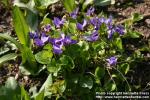On the medicinal herblist in Apr97,
by Karen Vaughan
Violets (Viola odorata, V. tricolor, V. calcarata, V. canadense, V. palmata,V. pedata, V. rotundifolia, V. pubescens and most of the other wild or cultivated species of violets and pansies) are some of the most underappreciated, important tonic herbs.
 All parts of the plant are used: the leaf, flowers, root and whole-plant tincture. The slipperiness of the leaf when you chew it is a good indicator of its medicinal value. The salicylic acid found in all parts of fresh violets is an active disinfectant and tissue solvent. and can be applied externally to soften hard skin, corns and warts. It is also fungicidal.Vitamins C and A are found in large amounts in the leaves. The roots are rich in minerals. And the small leaves and Spring flowers make a fantastic salad!
All parts of the plant are used: the leaf, flowers, root and whole-plant tincture. The slipperiness of the leaf when you chew it is a good indicator of its medicinal value. The salicylic acid found in all parts of fresh violets is an active disinfectant and tissue solvent. and can be applied externally to soften hard skin, corns and warts. It is also fungicidal.Vitamins C and A are found in large amounts in the leaves. The roots are rich in minerals. And the small leaves and Spring flowers make a fantastic salad!
The leaf is nutritive, alterative, dissolvent (anti-neoplastic, depurative, supperative), mucilaginous (expectorant, demulcent, laxitive, diuretic) and anodyne (vulnerary, antiseptic and emollient). It contains 264 mg of vitamin C and 20,000 IU of vitamin A per 100 grams of fresh leaf, as well as salicylic acid. It is useful for cancer or other growths: an overnight infusion of a quart jar filled with fresh leaves and topped with boiling water is good for cancer, fibrocystic breast disease, or mastitis, and makes a good gargle/mouthwash for gingivitis, ulceration of the mouth, pain from mouth cancers or herpes sores. The infusion is good for the nervous system, eyestrain, too much sun, bronchitis, sinus infections or ear infections.The strained leaves should be used to poultice cancerous or fibrocystic growths and can be used on the back of the neck for stress, insomnia, and nervousness. The small wild violet leaves in a honey poultice, hot fomentation or compress form are especially good for wounds, abscesses, swellings, herpes lesions, skin rashes and acute conjunctivitis.
The Spring pseudo-flower (true seed-bearing flowers which are green and hidden come in the Fall) is antiscorbutic and aperient. All Viola-flowers are edible. Make an olive oil infusion for tinnitus. Make a flower syrup to soothe sore throats, coughs, stomache ache, constipation and digestive distress. (1-5 tsp/day)
Violet roots are antipyretic, diuretic, expectorant, emollient, emetic and cathartic. Violet root is used for reducing coughs, cooling fevers, and soothing sore feet. It can be toxic in excess. In Europe cough syrup is made from violet root. Viola odorata root tincture (5-15 drops per day) or Viola tricolor (pansy) root tincture (5-25 drops perday) are used for respiratory distress, to cool fevers and break up mucus.Pansy root tincture reduces congestion and moves urine. Viola odorata root tincture also calms coughs, reduces inflammation, clears the lingering effects of pertussis and reduces hysteria. The fresh or dried roots, crushed and steeped for several hours in vinegar are used to poultice sore, hot, infected feet and the feet of diabetics.
The whole plant tincture of Viola tricolor (pansy) is specific for cradle cap, impetigo, and scabies. Use it internally for a week or two for cradle cap or impetigo. (2-5 drops for children; 15-100 for adults.) For scabies, use in combination with baths in green soap and sulphur flour or ointment until gone. Pansy tincture is also tonic and pain relieving to the heart.
Toxicity: some people are susceptible to dermatitis from the leaf externally (internally no known toxicity). Large doses of the roots or seeds (from the true flowers, not the colored pseudo-flowers) can cause severe stomach upset, nervousness, high blood pressure and breathing irregularities.
Non-medicinally, I like to make violet flower vinegar for salads and marinades (good with mint.)
- Violet yogurt is tasty and makes a good facial- stir in flowers to a good fresh yogurt and leave overnight.
- Candied violets are delightful for cake decoration, but I can never get mine to crystalize in a pretty enough position- mine look like purple sodden lumps. Better crystalizers sell them commercially.
- To make a nice greeting card, put a violet or dark pansy flower in the pages of a cotton rag-paper notebook. Tap repeatedly with a mallet (or whatever) until the flower impression comes through the paper.
- You can make homemade litmus solution by filling a jar with violet flowers and boiling water. Strain after steeping it overnight. Acid turns it purple/red and base turns it yellow/green. Use to test whether your bilberry plant's soil needs acidifying.
Howie Brounstein has a funny nomination for violets as the newest fad herb (move over Noni!) http://www.botanicalstudies.net/herbalism/fad.php
Keep transplanting them to your garden. (Transplanting is my favorite weeding strategy!)
Karen Vaughan

